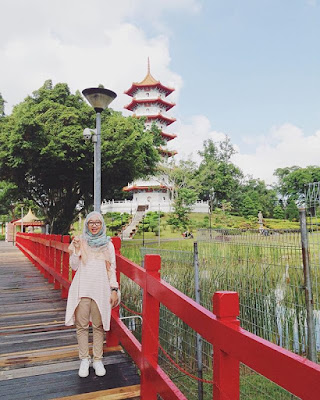Chinese Garden
1 Chinese Garden Road
Singapore 619795
Free admission
Chinese Garden, together with its sister park, Japanese Garden, are at
the heart of new, upcoming Jurong Lake Gardens. While work has started
at the adjacent Jurong Lake Park to transform it into Jurong Lake
Gardens West and both the Chinese and Japanese Gardens will continue to
stay open to the public up till 2018.
The Chinese Garden first
opened in 1975. This makes it more than forty years old. While it
doesn’t have the glamour of Gardens by the Bay or the pedigree of
Singapore Botanic Gardens, it is still one of the most characterful
parks in Singapore.
In 2015, it was given a sprucing up with
architectural repairs, along with electrical and repainting works. In
2016, it received a further boost to its visitorship with sightings of
rare Pokemon at the Chinese Garden drawing droves of Pokemon trainers.
But,
there are more reasons to visit the iconic Chinese Garden than
Pokemon-hunting. The Chinese Garden offers a landscape that is unique in
urban Singapore. As a consequence of its setting on an island in Jurong
Lake, it offers a tranquil place to escape to – particularly on
weekdays when there are fewer visitors to the park.
There are some sites that I want to tell you.
1. The East Entrance
This entrance was specially constructed in
conjunction with the Chinese Garden MRT station, to ensure easy access
for pedestrians visiting the gardens. Upon approaching the garden, there
is a Red Bridge that will lead you in. This Red Bridge symbolises good
luck and is an auspicious colour for the Chinese. Four stone lions,
welcoming the visitors before entering the garden, also guard the
entrance.
2. Main Arch Building
At the end of the 13-arch bridge is the Main
Arch Building. Two broad sets of stairs lead upwards to the imposing
building. Inside, there are two courtyards and fish pond filled with
koi.
Since 2002, the Main Arch Building has been home to the Live
Turtle and Tortoise Museum. Inside the museum is a private collection of
live turtles and tortoises (what else). These are kept in enclosures
and tanks. There are also free-ranging turtles and tortoises wandering
around its open-air garden.
Besides the animals, there are also
over 3,000 turtle and tortoise-related items in the museum. However, the
best way to experience the private museum is to purchase some leafy
greens from the counter and feed the animals.
The Live Turtle and Tortoise Museum is open from 9 am to 6 pm daily with a small entrance fee.
3. Bonsai Garden
Open from 9 am to 5 pm daily, the Bonsai Garden was
added on to the Chinese Garden in 1992 and built in the Suzhou-style.
Once you get past the two imposing terracotta warriors guarding the
entrance, you will feel as if you have wandered into an traditional
Chinese home – one filled with bonsai.
4. Landmarks Around Chinese Garden
Chinese Garden is built in the
northern Chinese imperial architectural style of the Song Dynasty (AD
960-1279). As a result, you will find unique landmarks such as the Stone
Boat and Tea House within its grounds.
The most noteworthy of landmarks in the Garden are its pagodas.
There are three in total – a pair of twin pagodas abutting the waters of Jurong Lake and a towering one atop a hillock.
The twin pagodas are each three-storeys tall and accessible for the public to make the climb to the top.
Getting to Chinese Garden
Chinese Garden is open from 5.30 am to 11 pm daily. Admission is free.
Chinese
Garden is easily accessible via the MRT. Firstly, from Chinese Garden
MRT Station, head in the direction of the Cloud Piercing Pagoda. Then
cross a small red bridge to get to the Chinese Garden (albeit not by the
main entrance). There are no food outlets at the Chinese Garden except for a little kiosk selling drinks and ice cream by the Main Entrance.











.JPG)



No comments:
Post a Comment
Drop your question here. Thank you! 😊